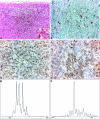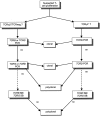BIOMED-2 multiplex immunoglobulin/T-cell receptor polymerase chain reaction protocols can reliably replace Southern blot analysis in routine clonality diagnostics
- PMID: 16237219
- PMCID: PMC1888492
- DOI: 10.1016/S1525-1578(10)60580-6
BIOMED-2 multiplex immunoglobulin/T-cell receptor polymerase chain reaction protocols can reliably replace Southern blot analysis in routine clonality diagnostics
Abstract
To establish the most sensitive and efficient strategy of clonality diagnostics via immunoglobulin and T-cell receptor gene rearrangement studies in suspected lymphoproliferative disorders, we evaluated 300 samples (from 218 patients) submitted consecutively for routine diagnostics. All samples were studied using the BIOMED-2 multiplex polymerase chain reaction (PCR) protocol. In 176 samples, Southern blot (SB) data were also available, and the two types of molecular results were compared. Results of PCR and SB analysis of both T-cell receptor and immunoglobulin loci were concordant in 85% of samples. For discordant results, PCR results were more consistent with the final diagnosis in 73% of samples. No false-negative results were obtained by PCR analysis. In contrast, SB analysis failed to detect clonality in a relatively high number of samples, mainly in cases of low tumor burden. We conclude that the novel BIOMED-2 multiplex PCR strategy is of great value in diagnosing patients with suspected B- and T-cell proliferations. Because of its higher speed, efficiency, and sensitivity, it can reliably replace SB analysis in clonality diagnostics in a routine laboratory setting. Just as with SB results, PCR results should always be interpreted in the context of clinical, immunophenotypical, and histopathological data.
Figures



Similar articles
-
Molecular immunoglobulin/T- cell receptor clonality analysis in cutaneous lymphoproliferations. Experience with the BIOMED-2 standardized polymerase chain reaction protocol.Haematologica. 2003 Jun;88(6):659-70. Haematologica. 2003. PMID: 12801842
-
Design and standardization of PCR primers and protocols for detection of clonal immunoglobulin and T-cell receptor gene recombinations in suspect lymphoproliferations: report of the BIOMED-2 Concerted Action BMH4-CT98-3936.Leukemia. 2003 Dec;17(12):2257-317. doi: 10.1038/sj.leu.2403202. Leukemia. 2003. PMID: 14671650 Review.
-
T-cell receptor gamma gene rearrangement by multiplex polymerase chain reaction/heteroduplex analysis in patients with cutaneous T-cell lymphoma (mycosis fungoides/Sézary syndrome) and benign inflammatory disease: correlation with clinical, histological and immunophenotypical findings.Br J Dermatol. 2005 Sep;153(3):565-73. doi: 10.1111/j.1365-2133.2005.06649.x. Br J Dermatol. 2005. PMID: 16120144
-
PCR-based analysis of rearranged immunoglobulin or T-cell receptor genes by GeneScan analysis or heteroduplex analysis for clonality assessment in lymphoma diagnostics.Methods Mol Biol. 2013;971:65-91. doi: 10.1007/978-1-62703-269-8_4. Methods Mol Biol. 2013. PMID: 23296958
-
Molecular genetics and lymphoproliferative disorders.J Clin Lab Anal. 1996;10(6):359-67. doi: 10.1002/(SICI)1098-2825(1996)10:6<359::AID-JCLA7>3.0.CO;2-1. J Clin Lab Anal. 1996. PMID: 8951602 Review.
Cited by
-
Comparison of BIOMED-2 versus laboratory-developed polymerase chain reaction assays for detecting T-cell receptor-gamma gene rearrangements.J Mol Diagn. 2010 Mar;12(2):226-37. doi: 10.2353/jmoldx.2010.090042. J Mol Diagn. 2010. PMID: 20181819 Free PMC article.
-
Combined detection of lymphocyte clonality and MALT1 translocations in bronchoalveolar lavage fluid for diagnosing pulmonary lymphomas.Sci Rep. 2021 Dec 6;11(1):23430. doi: 10.1038/s41598-021-02861-4. Sci Rep. 2021. PMID: 34873224 Free PMC article.
-
PiggyBac-mediated cancer immunotherapy using EBV-specific cytotoxic T-cells expressing HER2-specific chimeric antigen receptor.Mol Ther. 2011 Dec;19(12):2133-43. doi: 10.1038/mt.2011.131. Epub 2011 Jul 19. Mol Ther. 2011. PMID: 21772253 Free PMC article.
-
Detection of immunoglobulin and T-cell receptor gene rearrangements in angioimmunoblastic T-cell lymphoma.Int J Clin Exp Pathol. 2018 May 1;11(5):2642-2653. eCollection 2018. Int J Clin Exp Pathol. 2018. PMID: 31938379 Free PMC article.
-
Diagnostic significance of TCR gene clonal rearrangement analysis in early mycosis fungoides.Chin J Cancer. 2011 Apr;30(4):264-72. doi: 10.5732/cjc.010.10344. Chin J Cancer. 2011. PMID: 21439248 Free PMC article.
References
-
- Van Dongen JJ, Wolvers-Tettero IL. Analysis of immunoglobulin and T cell receptor genes. Part I: basic and technical aspects. Clin Chim Acta. 1991;198:1–91. - PubMed
-
- Derksen PW, Langerak AW, Kerkhof E, Wolvers-Tettero IL, Boor PP, Mulder AH, Vrints LW, Coebergh JW, van Krieken JH, Schuuring E, Kluin PM, van Dongen JJ. Comparison of different polymerase chain reaction-based approaches for clonality assessment of immunoglobulin heavy-chain gene rearrangements in B-cell neoplasia. Mod Pathol. 1999;12:794–805. - PubMed
-
- Shadrach B, Warshawsky I. A comparison of multiplex and monoplex T-cell receptor gamma PCR. Diagn Mol Pathol. 2004;13:127–134. - PubMed
-
- Droese J, Langerak AW, Groenen PJ, Bruggemann M, Neumann P, Wolvers-Tettero IL, Van Altena MC, Kneba M, Van Dongen JJ. Validation of BIOMED-2 multiplex PCR tubes for detection of TCRB gene rearrangements in T-cell malignancies. Leukemia. 2004;18:1531–1538. - PubMed
Publication types
MeSH terms
Substances
LinkOut - more resources
Full Text Sources
Other Literature Sources

